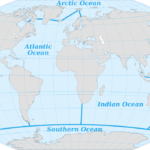The waters of the Earth’s oceans are for the most part in liquid form. What happens when you take a half full bottle of water and shake it up? Do you see the bubbles swirling rapidly around inside the water bottle? While liquid water molecules do generally attract one another forming a body of water, molecules within that body of water are free to move about, becoming thoroughly mixed up.
The waters of the Earth’s oceans can be mixed up by a number of forces, including wind, splashing against a rocky shore, swimmers, boats, etc. However, the items mentioned above create only a very minimal amount of mixing. Three important forces create a much more prevalent mixing of the ocean’s waters, causing the water to move about from one place to another, as though a giant were shaking them in the same manner that you shake a water bottle.
These forces are waves, currents, and ocean tides.
Ocean Waves
The surface of the Earth’s oceans is in constant motion, moving up and down in the form of waves. If you have been to a beach, you have witnessed waves first hand.
Waves form as energy is transferred from molecule to molecule across the surface. In general, the water molecules move very little. It is only the energy that actually moves.
However, as waves break across a shore or crash in violent storms, they can be the source for great mixing of an ocean’s water.
Ocean Currents
There are a number of ocean currents found around the Earth. A current is like a vast river within the ocean, flowing from one place to another. These currents are caused by differences in temperature, differences in salinity, and by wind. Currents are responsible for a vast amount of movement of the water found in the Earth’s oceans.
Tides
By far the most important factor affecting the movement of water across the ocean is the tides. Tides are great bulges of water caused by the gravity of the Moon and Sun. Attracted by gravity, these bulges move around the Earth’s oceans, causing water levels to rise and fall. Typically water will rise for about six hours, followed by six hours of falling water depths.






